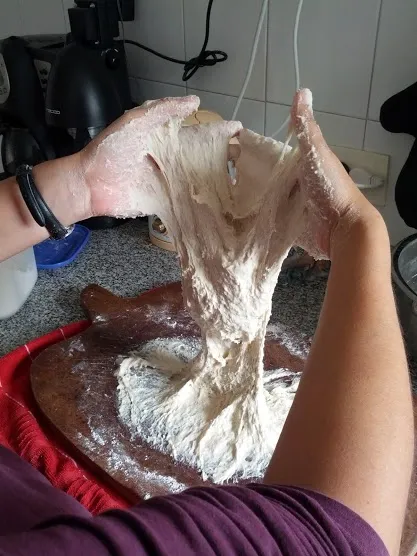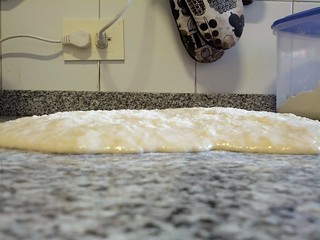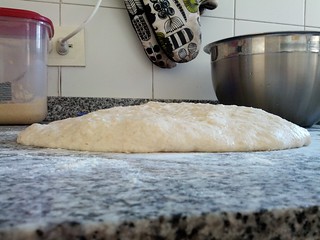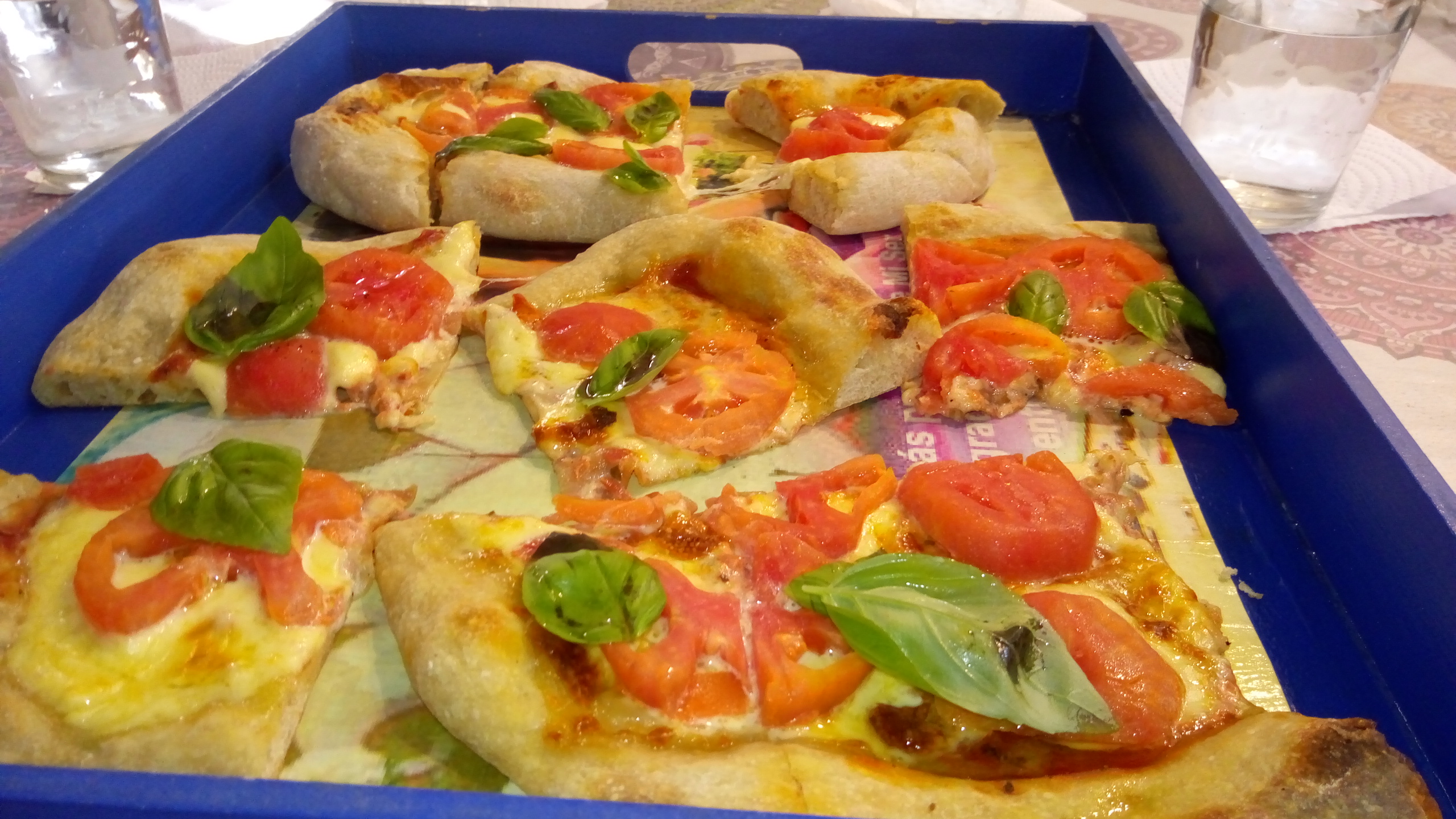
I've gotten a lot of useful advice from TFL over the past years but finally after a year and a half of breadmaking failure I am reaching out for help.
I've been a bread baker for about three years. For the past year and a half I have been living in Buenos Aires, Argentina and have been trying to recreate the breads I loved in the US using locally sourced ingredients and
equipment, mostly with disastrous results. I'm reaching out now for help to see if anyone with more experience can help me interpret what's happening to my breads.
The short version of the story is that the doughs I produce end up too wet and with no structure, compared to similarly hydrated doughs I produced in the US. After some research, I believe this is because Argentine bread
flour has a lower percentage of protein/gluten than either AP or bread flour in the US. I documented this in detail on my blog: http://tlau.org/food/2013/05/argentine-bread-flours/
To compensate for that, I have been trying to supplement the flour with more gluten. I can obtain something called harina glutinada which claims to have 42% protein according to the label. So I have been mixing this with the standard bread flour to obtain what I believe should be flour with around 14% protein. (From this link it looks like US bread flour has 12-14% protein.) I also imported some Bob's Red Mill vital wheat gluten during my last visit to the States (75% protein) and have experimented with adding that to the flour as well.
My first experiments seemed promising. My basic recipe is Emily Buehler's "basic bread" from her Bread Science book. It's a 70% hydration dough, optionally made with a poolish, that I am forming into two baguettes using a French bread pan. Experiments with increased gluten levels yielded decent-looking baguettes: http://tlau.org/food/2013/05/a-tale-of-two-breads/
More often, however, I struggle with doughs that are too wet and gloppy, coming out more soupy than firm. For one example, I tried making Bittman's original No-Knead Bread recipe using a mixture of bread flour and harina glutinada to end up with a supposedly 12% protein flour mix (435g of 10% protein flour, 45g of 42% protein flour -- can someone check my math?). After the first 14-hour rise, the dough poured out of the bowl, more soup than dough:

It's the same result as if I hadn't increased the gluten at all -- I had been seeing similar results trying to use unmodified flour.
More recently, I made my first dough using a sourdough starter that I began a week ago. The final dough had 64% hydration, plus a 21% proportion of starter (which has been maintained at a 1:3:2 starter:flour:water ratio, according to Reinhart's Artisan Breads Every Day starter formula). I made a 16% gluten flour mix (471g 10% flour, 109g of 42% harina glutinada). With this low hydration, I would expect the dough to be rather dry, and in fact right after I mixed all the ingredients together, the dough was indeed very dry -- when I started kneading, not all the flour had been incorporated into the dough. After kneading, the dough felt tacky but not sticky; my fingers would stick to the dough but peel away clean. The windowpane test showed that the gluten had developed.
Yet after an overnight rise, the dough had turned back into soup:

It's behaving like an extremely wet dough, sticking to my fingers and to the counter, not at all how I'd expect a 64% hydration dough to behave based on what I've read online and seen on YouTube.
These experiments are very consistent with what I've been experiencing in the past year and a half (without a starter, just using commercial yeast) using locally sourced ingredients. I have read that higher protein levels enable the flour to absorb more water, which is why I have been trying to increase the protein level using glutinated flour. Yet it still does not seem to be enough. Does anyone have any other possible explanations for why my doughs are turning out so wet?
Yes, I know that I can reduce the amount of water, but I am (of course) still striving for those big holes characteristic of artisan bread, and decreasing the water seems to be at odds with trying to get the big airy breads.
Help?
I've never used harina aglutinada, so I'm not sure what it's properties are. You are correct, that U.S. bread flours are typically around 12% protein. IMHO, your problem is in the starter and not the flour. The same thing happened to my starter when it got underfed and became proteolytic (i.e. started breaking down the gluten) - the longer the dough fermented, the more it just turned to a soupy mess. What is your starter routine (what kind of flour, feeding ratios, feeding time)?
Hi yy, thanks for the response!
I should have de-emphasized the starter part of my post -- I get this result whether or not I'm using my own starter. (It just happened to be the most recent experiment, so it's in my recent memory.) I get the same result using commercial yeast, unmodified flour, and a 70% hydration dough -- it just turns into soup.
The no-knead bread example I mentioned earlier in my post didn't use a starter, for example. And it did use a modified flour mixture.
I would like to understand why all of my doughs turn to soup. What properties of the flour are causing this soupiness, when the original mixture starts out almost too dry?
Have you ever made breads from doughs that were "not so wet"(less than 70%), with this flour(s)?
Do you know of anyone making satisfactory breads with this flour?
I've reduced the amount of water significantly (down to around 55%) and made satisfactory (but not artisan-quality) breads. Only recently have I started taking detailed notes and trying to understand scientifically what's going on, so I don't have exact numbers for past experiments.
One problem is that the flour supply is very inconsistent; each time I go to the grocery store I have to buy a different brand of flour because it's all they have.
I do not know anyone else making satisfactory breads with this flour, unfortunately. I think I'm blazing new ground here! I did find a few threads on TFL about Argentine flour, but no one trying for artisan-quality bread as I am.
Have you tried more aggressive portions of the harina glutinada. Forget about the "complex gluten calculations", for right now. Maybe see what happens if you use a mixture of 80% "bread " flour + 20% of the harina glutinada. 75/25, 70/30, etc.
This is just in hoping that harina glutinada is something other than vital wheat gluten. Maybe it is a true high gluten flour.
Assuming the harina glutinada is wheat flour, I would think you could eventually come up with a satifactory blend. If not, you might try the same with the Bob's V.W.G.
By the way, if you get to the point where you can be certain about the specifications of the Argentine flours, there is an online tool designed to blend flours of various known protein percentages to result in a desired level. Use the "mixed mass..." calculator on the right.
http://tools.foodsim.com/
Good luck.
Thanks, I'll try higher proportions of the harina glutinada and see what happens. The bag says (translated): "dietary flour with high gluten content". Am I on the right track trying to mix larger proportions of glutinated flour in with the basic flour? I'll bake more experiments and report back with the results.
I also found something claiming to be "100% gluten" in a specialty foods store, but haven't tried baking with it yet.
And thanks for the mixed mass calculator link! I did the same calculations in a spreadsheet but I'll use that to check that I'm doing the calculations correctly.
I started a batch today using local bread flour + Bob's Red Mill (imported) vital wheat gluten, mixed to form what I calculated as a 20% protein dough. It behaves *very* differently than most of my doughs -- very springy and almost kneads itself. I think I can feel what the dough should be like with high gluten content. I can use this to experiment with higher proportions of the harina glutinada to see at what proportion it gets the same consistency.
when looking for a local wheat flour, I find myself searching for the highest protein combined with the lowest carbohydrate amount gram wise. Check and compare fiber too. Those flours will tend to absorb more moisture but you still may find yourself reducing the water. I would try a basic bagel 50% hydration and work up.
What are the dough temps? Are you using any "stretch and folds" with the higher hydration doughs?
Thanks for the pointers! What difference do carbohydrates and fiber make? Do I want flours with more fiber or less? Why would I want lower carbs?
The dough temps are room temperature, which in this season is around 66-68 degreesF but can rise to the 70's in the afternoon when the kitchen gets sunny.
I've tried stretch-and-folds with the higher hydration doughs. I understand how they're supposed to work; back when I was in the US, I used stretch-and-fold successfully on Reinhart's pain a l'ancienne 80% hydration dough, and it was obvious that the stretch-and-folds were adding more strength to the dough. However, with the dough I've made here, an 80% hydration is so liquid that stretch-and-folds have no effect.
Just a thought... what are the local breads like and what do the local bakers use/do?
Local breads are bland and tasteless. Although there are bakeries on every block, they focus on sweetened pastries and cakes rather than artisan breads. The most common bread is a white dinner roll (like a baguette which is torn apart into individual chunks) which is dry and tasteless with a pale crust. I've heard that bakeries are so lazy that they get their dough delivered daily from a factory rather than making it themselves.
I've found one bakery (L'Epi) which produces a mild form of sourdough using naturally-leavened dough. It's not as strongly flavored as San Francisco sourdough, but it does have some mild sour flavor to it, and a nice crispy crust. They have real baguettes, boules, and miches. Unfortunately it's out of the way so I can't go there too often.
At least it's good motivation to bake my own delicious bread!
A good place to ask about the flour! Get there very very early and ask about flour and special techniques.
A month ago I was in San Martin de Los Andes on a Sunday, a chain bakery had outside banner size advertising (slightly faded) showing fantastic breads and a brioche. My husband suddenly craved brioche. He waited outside as I cased the joint. Although the town is spackled with generations of European influence, the bakery was full of cookies, biscuits and pastries. Product looked aimed for small portion picnic style afternoon coffee. No Sunday brioche to be seen or detected. Not even half a brioche or small twists or knots. (sad) But we did find some wines and makings for our traveling dinner in the supermarket across the street, they had more bread variety. It can very well be that the bakery offers more bread selection during the week.
My thought was to try and find out what flour they use and where they source it - assuming that it is any good.
I found an old paper on Argentinian wheat that may shed some light on your problem, esp.. section 10.6 on page eight. No solution though
http://www.muehlenchemie.de/downloads-future-of-flour/FoF_Kap_10.pdf
hmmmm... I think that I need to get a life :-)
Wow, that's incredibly interesting -- thanks for finding that! The lack of quality standards would explain my inconsistent results with commonly available flour here. The report seems to date from 10 years ago, though; I'm really curious what has happened since then and whether the exporters were able to put quality standards in place more recently.
I never imagined that gluten quality could be an issue, but low gluten quality could explain why I'm having to increase my gluten percentage to levels that seem insanely high to US bakers.
Yesterday's experiment was a 20% gluten dough mixture (using imported Bob's Red Mill vital wheat gluten, which probably has high-quality gluten in it) and the result was an astounding success. The dough came together well, was nice and bouncy, and generated a huge amount of oven spring and a nice fluffy texture.
I'll continue my experiments with the locally sourced high-gluten flours, now with the added knowledge that I may need to use higher than normal gluten ratios because of the low quality of the gluten.
Thanks for all this research, it's incredibly helpful!!
http://www.muehlenchemie.de/english/know-how/future-of-flour.html
Thanks for finding this link - It's now added to my favourites - I will be able to bore my missus so much with my newly acquired deep-geekery!!
in a standard dough, one you know very well and familiar with inside and out. Substitute part of the water with egg white. Try first one for about every 500g of flour. Egg whites contain a large variety of proteins and may help link the proteins in the flour together. Let the dough autolyse for 20 minutes before working in the salt which tightens the bonding. Please lower the hydration just a little bit and add later if needed.
Mini
Thanks Mini! Unfortunately I'm vegan, so eggs are out. But it's an interesting idea, and maybe will help others out!
Have you noticed any improvements using scalded milk products?
No, I haven't tried enriched doughs -- still trying to master a basic lean dough.
Thanks for all the suggestions and research on how to deal with the bread flour in Argentina, where I live.
After several months of experimentation I'm happy to report that I think I understand how to get consistent results now! The key has been to add more gluten to the basic bread flour available here. I found a local store that sells a product labeled "100% gluten", and when I add it to my doughs such that the total protein percentage is in the 15-20% range, it behaves like a normal dough made with US flour.
@Fatmat's research on the lower gluten quality in Argentine-sourced wheat was the key indicator which made me try adding abnormally high levels of gluten only to find that what seems abnormally high actually made the dough behave significantly better.
I have also had some success incorporating my sourdough starter into my loaves (which has necessitated adding even more gluten, up to 21% in the final dough to make it strong enough). They don't taste too sour yet but my starter is still young and I expect it to develop more flavor as time goes by. The loaf below even developed a nice crackling crust with some small bubbles on it -- I'm so proud of it!
My latest round of reading (from this TFL thread) has discovered that almost all bread flour made in the US contains added malted barley (aka diastatic malt) which contains enzymes that help the yeast create a strong rise, more oven spring, and a better crust. I'm fairly certain this ingredient is not added to Argentine flours (it's not on the label), which may also explain my difficulty getting a good loaf. I'm now on a quest to find this ingredient in Argentina (a previous TFL thread did not yield any sources) to see if that improves my bread even further.
Thanks again for all the help so far on this long quest!
i know its an old post, but what its the porcentage of glute you used? i live in argentina and this problem its driving me crazy
Hi @marekmars,
These are the ingredients I used for my most successful loaves:
521g tipo 000 flour
59g gluten
406g water
12g salt
3g yeast
It's just a starting point for you to develop your own recipe. Good luck!
Hi! I know this thread is really old, but somehow after reading it, I could start making better bread! I live in Argentina as well and was wondering if you've found any flour brand here that is suitable for baking a nice sourdough bread? and if not, how do you use diastatic malt?
Hola Ramiro! It's been a while (I moved back to the States several years ago) but I think that any regular flour brand worked fine, as long as I supplemented it with "100% gluten" from the specialty store. I don't remember exactly where, but I would look for health-foods stores which have bulk items in containers (including 100% gluten) where they weigh it out for you at the counter.
I never was able to find the diastatic malt locally.
Hola Tlau! Muchas gracias! I've tried the adding gluten with your proportions and got amazing results!! not getting the crispy bubbly blistery crust I see in US pictures but I think it has more to do with the fact that my loaves don't get enough steam... This thread was quite a revelation for me since I've been able to do bread with (until now) up to 70% hydration!!! Which if I would try with flour only it'd be a complete mess! I attach one pic of the first (though underproofed) big oven spring I've achieved... I was wondering if you, by any chance, know the proportions of diastatic malt I should use... I might be able to get some...
Thank you very much once more!
This page on diastastic malt suggests using about 0.5-1 tsp for 3 cups of flour:
https://www.kingarthurflour.com/shop/items/diastatic-malt-powder-16-oz
If you can find some, I would try starting with that and document your results. I kept a record of each of my experiments so I knew what worked and what didn't.
Buena suerte!
Thanks for compliments on the bread!! YW leavened! por cierto, tus panes se ven increibles tambien!! Did You bake it in a DO?
Thank you veeery much for the link! I have a friend of mine that's traveling to the US and might be able to get some there too!! So I make sure it is of good quality!
I am keeping a record of the experiments too... It's a bit messy so I'll have to pout some order... But this far this good! Today I baked some 70% YW pizza and the dough was superb! A friend of mine did something similar without adding gluten and using SD starter and the dough was almost falling apart... Could manage to bake some good pizzas out of it anyways!
Muchas gracias!!!
P.s... The pic is one of the pizzas made with the YW levain...
Hey! I’m a US native living in Paraguay at the moment and I have been struggling with using flour here for a while. This thread is a lifesaver! I’ve already ordered some gluten and nondiastatic malt (apparently this is good if you just want the color) from the states (not sure yet if I can get either here).
Anyway, I wanted to know how you determined how much gluten to add. Are you doing 1:1 relaxing flour with gluten or the gluten doesn’t impact how much flour you put in or what exactly? Any help would be appreciated!
This thread was so helpful! I am down in BA visiting family and brought my masa madre starter from DC. The starter is fine but my first loaf was a structureless pancake despite extra folding to build strength. Because of this thread I went to buy 100% gluten and my bread came out great. Since it's hard to find in the US, I mixed in some fresh yeast. The bread didn't brown as much as like but the flavor and crust were great.
Thank you all.
-Adam
When I was there I followed Tlau's suggestion and added vital wheat gluten at 20% of total flour weight. I found it to be a great starting place. Folks could always adjust up and down.
As she said the bread in Argentina is pretty lousy - generally like a soft sponge - even the 'artisanal' bread. It's always surprised me. ( And don't get me started on cheese!).